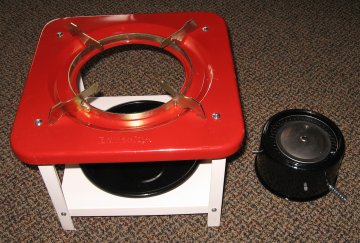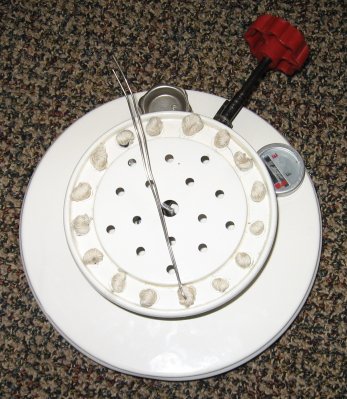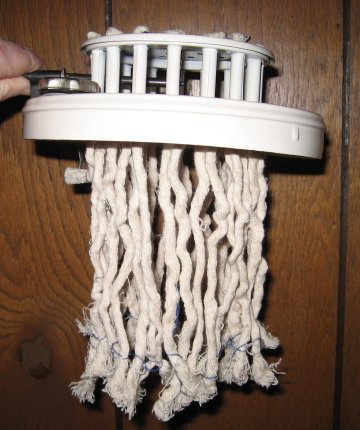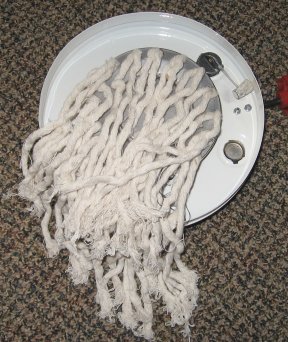|
SITE
INDEX
QUICKENING
NEWS
PREPARATIONS
1.
Food
2.
Manna
Meals
3.
Water
4.
Sanitation
5.
Medical,
health
6.
Kerosene heaters and cookers
7.
Lighting
8. Wood
cooking and heating
9. Communi-cations
10. Essential
Tools
11. Home
built items
12.
Electrical; generators
and power
13. War
preparedness
14.
Gardening
SITE
INDEX
Miles Stair's SURVIVAL
SHOP
HOME
RADIATION
INDEX & JET STREAM
PROPHECY
COMMENTARY
BY MILES
BOOKLETS
BY MILES
GUEST
SUBMISSIONS
PHOTO
INDEX
LINKS
SITE
INDEX
Miles Stair's SURVIVAL
SHOP
|
|
BUTTERFLY #2487, 16 WICK
STOVE
The Butterfly
#2487, 16 wick stove is the first Butterfly stove I
have used which is large enough - and strong enough -
to hold a large stock pot or water bath canner. I
decided to put the #2487 to a tough test, boiling 4
gallons of water in a tall stock pot while breaking in
the stove. During break-in, the wick tops
are hardening and thus are not properly trimmed until
after the first good burn, so the maximum heat
potential is not reached. Nevertheless, the
Butterfly #2487 shown below brought 4 gallons of water
to a boil inside of 25 minutes. This stove
is capable of canning or large pot
simmering, like reducing/condensing tomato sauce or
maple syrup. The maximum heat output is also
easily sufficient for baking bread using the Butterfly
#2421 oven. Yet by lowering the wicks, a low heat
can be maintained for frying eggs or whatever without
burning. This stove is the best one for use with
the Butterfly #2421
oven.
[This stove is available from
St. Paul Mercantile.]
|

|
Shown at
left is the Butterfly #2487. At a little
over 12 inches wide and 9 inches high, the #2487
is small enough to be portable. The 11 1/2"
wide pot/pan support bracket is easily wide
enough to support large pots, while the folded
corners lend sufficient strength to hold the
weight easily.
|
|

|
The #2487
shown here with the wick mechanism and burner
removed. The fuel tank is seamless and
therefore does not spill easily when moved - a
huge improvement over earlier Butterfly stove
designs. To light the wicks, the handle on
the "burner" is raised, exposing the wicks.
A long bamboo skewer is easier to use than a
match.
|
|

|
The
Butterfly #2487 comes completely assembled
except for installation of the
supplied wicks. I use a foot long piece of
soft wire with a fold for a hook at one end, fold
the wick in half, and pull the wick up through
the wick tube from the bottom. The height
of the wick above the top plate is irrelevant at
this point. It is important to note on the
photo at left the raised outer ring around the
wicks and the raised inner section - those raised
sections are the guides for proper, level wick
trimming.
|
|

|
View of the
wicks pulled through the wick tubes. Note the
wicks protruding above the top - above the trim
guides as shown in the photo above. At this
point the wicks can be manually pulled down from
underneath until the tops are all level with the
trim guides. After the initial wick
installation, when the top of the wicks become
ragged or coated with tar, the wicks are pulled
up one at a time. Then sturdy shears or
scissors are laid flat across the wick guides and
the top of the wicks snipped off. It
actually takes very little time to trim the
wicks.
|
|

|
At left is
a view of the wick raising mechanism upside down,
wicks installed. The beauty of a multi wick
stove is in those wicks. All wicks become
ragged with use. Expensive wicks must then
be thrown out. But the long wicks used in
this stove need only have 1/4" snipped off the
top of a wick after extensive use - and there are
a lot of quarter inches in those long
wicks! When new wicks are eventually
needed, they can be purchased OEM wicks...or
strands from a cotton mop. With a
multi-wick stove you need never be out of
wicks!
|
As with all
kerosene powered equipment, the Butterfly #2487 should
be broken in for a couple of hours by burning it in a
location with draft but plenty of ventilation.
The catalytic converter ("burner") unit must get hot
for awhile to anneal the steel properly and burn off
any protective oil. It is best to do this work at
night so you can see the flame height.
All kerosene
stoves depend upon an even flame height for maximum
efficiency. If there is a "flame spike" caused by
a wick which is too high, the maximum heat output of
the stoves is limited because that one flame spike soot
up any cooking utensil if it impacts the base. If
you have problems evening the height of the individual
wicks, see Stove
Maintenance.
It is common
sense to use a kerosene stove near some ventilation,
and not move the stove while lighted and
hot.
|
|
|





